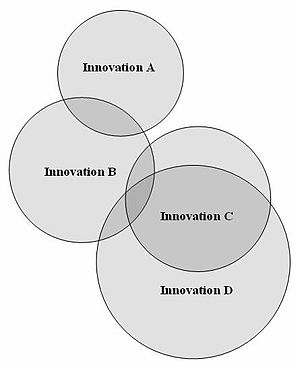Wave model
This article needs additional citations for verification. (January 2012) |

In historical linguistics, the wave model or wave theory (German Wellentheorie) is a model of language change in which a new language feature (innovation) or a new combination of language features spreads from a central region of origin in continuously weakening concentric circles, similar to the waves created when a stone is thrown into a body of water. The theory was intended as a substitute for the tree model, which did not seem to be able to explain the existence of some characters, especially in the Germanic languages, by descent from a Proto-language.
The tree model requires definite, stable languages, exactly what was denied by the Wave Model; if there are no permanent languages, then they cannot evolve as a tree. Conversely, the Wave Model regards languages as impermanent collections of features at the intersections of multiple circles. What really exists are dialect continua. Johannes Schmidt used a second metaphor to explain the formation of an impermanent language from a continuum. The continuum is at first like a smooth, sloping line. Speakers in close proximity tend to unify their speech, creating a stepped line out of the sloped line. These steps are the dialects. Over the course of time some steps become weak and fall into disuse, while others preempt the entire continuum. As example Schmidt used Standard German, which was defined to conform to some dialects and then spread throughout Germany, replacing in many cases the local dialects.
Despite their intent, the wave theorists did not manage to overthrow the Tree Model. Instead it has only been invoked[by whom?] to complement the Tree Model in cases where the latter cannot explain some features. The basic Tree Model has remained unusually effective[clarification needed] and resilient. In modern linguistics, the wave model has contributed greatly to improve the tree model approach of the comparative method.[1]
History of the model
Advocacy of the wave theory is attributed to Johannes Schmidt and Hugo Schuchardt.
In 2002-2007, Malcolm Ross and his colleagues theorized that Oceanic languages can be best understood as developing through the wave model.[2][3]
See also
References
- ^ Labov, William (2007). "Transmission and diffusion". Language. 83: 344–387. doi:10.1353/lan.2007.0082.
- ^ Lynch, John (2002). The Oceanic languages. Richmond, Surrey: Curzon. ISBN 978-0-7007-1128-4. OCLC 48929366.
{{cite book}}: Unknown parameter|coauthors=ignored (|author=suggested) (help) - ^ Ross, Malcolm and Åshild Næss (2007). "An Oceanic Origin for Äiwoo, the Language of the Reef Islands?". Oceanic Linguistics. 46: 456–498.
